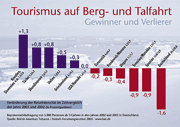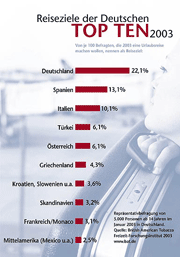19th German Tourism Analysis
British American Tobacco presents the 19th German
Tourism analysis by the Leisure Research Institute
Contrary to all economic forecasts:
The desire to travel remains unbroken
Optimism is the first holiday obligation. Despite all the crisis reports in the economy and politics, a positive mood is emerging in the travel market. The Iraq conflict, rising energy prices and higher social security contributions are clearly not dampening Germans' desire to travel in the long term. The willingness to travel remains stable. The firm travel intentions for 2003 show no change compared to the previous year (2002: 47% - 2003: 47%). Only the proportion of those refusing to travel (2002: 24% - 2003: 26%) increased slightly. These are the findings of the 19th German Tourism Analysis conducted by the Leisure Research Institute of British American Tobacco, in which 5,000 German citizens aged 14 and over were asked about their holiday behaviour in 2002 and their travel intentions in 2003.
"The conflicts in Afghanistan and Iraq as well as the attacks in Djerba, Bali and Kenya have not yet been able to stop the desire to travel," says Prof Dr Horst W. Opaschowski, Director of the Institute. "Once again, a tourist experience has been confirmed: tourists have a chronic short-term memory." After a longer phase of getting used to the problem, demand quickly picks up again. The travel industry benefits from the pent-up demand: almost every second German citizen is mentally sitting on packed suitcases.
The current results of the B.A.T Tourism Analysis 2003 contradict all statements about consumer uncertainty. German citizens know very well what they want to spend money on and in which areas they need to tighten their belts. Despite tight budgets, they continue to save on holidays last and foremost. However, the times when Germans could travel without limits and spend money without limits are over. The tourism industry is entering a phase of normalisation: instead of rushing from record to record as usual, it is better to be satisfied with lower growth rates.
Review of the 2002 travel season
Uphill and downhill tourism
Fear of crisis and economic downturn cause tourism to experience unparalleled ups and downs. In the success story of tourism, the 2002 travel year stands out. The travel intensity of German citizens who spent at least five days on holiday returned to the 1998 level (1998: 54% - 2001: 51% - 2002: 54%). However, this increase is mainly due to an increase in shorter trips of 5 to 13 days (2001: 10% - 2002: 15%), while the traditional annual holiday of at least two weeks' duration is losing ground for cost reasons (2001: 41% - 2002: 39%). The economic development is apparently reinforcing the trend towards shorter holidays.
Domestic destinations 2002
Baltic Sea and Bavaria extend top position
The 2002 travel season was a year with many ups and downs for German domestic travellers. Domestic holidays were less in demand (2001: 34.4% - 2002: 32.8%). At the same time, a split emerged in the domestic travel market: the holiday regions on the Baltic Sea (2001: 7.2% - 2002: 7.6%) and in Bavaria (2001: 5.5% - 2002: 6.5%) strengthened their leading positions, while holiday destinations on the North Sea lost share (2001: 6.2% - 2002: 5.3%). The Black Forest (-0.7 percentage points) and Lake Constance (-0.4) also attracted fewer holidaymakers.
"Competition for market share within Germany is getting tougher," says Professor Opaschowski. "The North Sea coast and North Sea islands are clearly feeling the competition from holiday providers in Mecklenburg-Western Pomerania and Schleswig-Holstein. The waves could be even higher here in the coming years." Bavaria can look forward to the renaissance of mountain and Alpine tourism, while the other holiday regions within Germany are finding it increasingly difficult to demonstrate their own profile.
Destinations abroad 2002
Spain. Tunisia. Morocco: The losers of the season
Spain, Tunisia and Morocco were the main losers of the 2002 travel season. Spain, "the" foreign holiday destination for Germans, seemed to be programmed for boundless growth in the 1990s. The holiday destination had an unparalleled success rate of 10 (1993) to 17 per cent (1999). Since then, however, Spain has suffered constant losses (2000: 16.0% - 2001: 14.8% - 2002: 13.9%). This equates to a double-digit drop in the proportion of German visitors.
The growth market of Spain can no longer deny its downsides. In many centres of Spanish mass tourism, the price-performance ratio is no longer right. Travelling is becoming more expensive, but the service is not improving. Dissatisfaction with the price-performance ratio is increasing. The economic development is also contributing to the shift in German travellers from Spain to Turkey (2001: 5.5% - 2002: 6.3%). The holiday regions in the former Yugoslavia, such as Croatia and Slovenia, are also among the winners of the economic crisis (2001: 1.5% - 2002: 2.8%), as they offer not only guaranteed sunshine and beautiful scenery but also inexpensive holiday offers.
For decades, there were only three top holiday destinations for Germans: Spain, Austria and Italy. Last year, Turkey almost overtook the classic holiday destination Austria (6.4%) for the first time. The Turkish Riviera has become the trend destination for Germans (2001: 5.5% - 2002: 6.3%). Greece is also slowly catching up (2001: 4.1% - 2002: 4.4%). And against the backdrop of uncertain air tourism, holiday destinations in Scandinavia (2001: 2.6% - 2002: 3.4%) could become serious competition for some southern regions. Only Italy was able to further expand its leading position (2001: 7.8% - 2002: 8.3%). Tunisia/Morocco (2001: 2.2% - 2002: 1.3%) suffered the greatest loss of share last season. They are particularly affected by the political crisis.
Opaschowski: "The long-haul travel market remains - for financial reasons alone - only an attractive supplement (and not an alternative) to Mediterranean holiday destinations. The big breakthrough is still a long time coming." The Caribbean, in particular Cuba and the Dominican Republic (2001: 1.8% - 2002: 0.8%) are no longer in vogue. And even trips to the USA (2001 and 2002: 1.6% each) will not be able to compete with the Mediterranean destinations of the Germans in the long term.
Destinations 2003
Italy. Croatia. Turkey: The upcoming winners
2003 will not be a normal year for travelling. In the new tourism year, many things will be different than in previous years: many travellers will change their plans and tour operators their routes. A redirection of travel flows is imminent. Travellers and tour operators are acting and reacting at short notice and flexibly. This is what characterises the special tourism situation in the coming season. Professor Opaschowski: "The industry can only dream of ‚early bookings‘ and ‚long-term cushions‘. More and more German citizens will only book their holiday a few weeks before the start of their trip. Other times, other destinations and other means of transport will be in demand, i.e. the economic and global political uncertainty will have a lasting impact on air travel in particular." Instead, more and more holidaymakers will opt to travel by car, bus and train or book a cruise, which gives a little feeling of security "like on an island".
The winners of the 2003 holiday season could be Italy and Turkey. Domestic holidays in Germany will only just be able to maintain their position, while the Italian and Turkish Riviera can expect growth rates. Turkey (travel intentions 2003: 6.1%) may catch up with Austria for the first time (2003: 6.1%). And Italy (2003: 10.1%) is moving ever closer to the front-runner Spain (2003: 13.1%). The countries of the former Yugoslavia (Croatia, Slovenia, etc.) will continue to be in demand (2003: 3.6%) and Tunisia/Morocco (2003: 1.3%) will surpass them in terms of attracting German holidaymakers.
The Caribbean (Cuba, Dominican Republic, etc.) will also be on the losing side (2003: 1.6%), while Central America (Mexico, etc.) will establish itself as the new in-destination for long-haul tourism (2003: 2.5%).
City tourism as a future market
Short breaks and city breaks are among the forms of travel with great future potential: 21st century travellers want to experience as much as possible in just a few days. City breaks are becoming highlights for short holidaymakers. Germany is also increasingly establishing itself as an attractive destination for city travellers.
Berlin. Munich. Hamburg: The most-visited destinations
Which destinations are currently most popular with city tourists? Germans' favourite destinations for domestic city breaks are Berlin (36%), Munich (24%), Hamburg (23%) and Dresden (21%). It is striking that Germans almost exclusively choose major cities or cultural metropolises as the destination for their city breaks. Dresden, Germany's Florence on the Elbe, now ranks ahead of many western German metropolises such as Frankfurt (13%), Düsseldorf (9%) and Stuttgart (9%).
When it comes to city breaks abroad, Germans favour Vienna (16%), Prague (15%) and Paris (15%). They are followed by London and Venice (11% each), Salzburg (10%), Rome and Barcelona (8% each). New York, Madrid, Istanbul and Copenhagen (4% each) as well as Lisbon and Stockholm (2% each) rank at the bottom. Professor Opaschowski predicts a further boost for city tourism from low-cost airlines in the future: "Air travel to metropolises such as London or Rome could particularly benefit from this."
City breaks abroad have been the domain of East Germans in recent years. More (47%) than West Germans (43%) have flocked and continue to flock to Western and Eastern European metropolises. East Germans favour Venice (+4 percentage points) and Paris (+3), Copenhagen (+4) and Amsterdam (+1) for their city trips. Western Germans are just more in favour of Rome (+4), Florence (+5) and Vienna (+1). And when it comes to Eastern European metropolises, the two visitor groups are worlds apart: In Budapest, East German visitors are twice as strongly represented (East: 16% - West: 8%). And in Prague, the proportion of East German visitors is even higher (East: 27% - West: 11%).
Vienna. Florence. Rome: The most attractive destinations
In the representative B.A.T survey, German tourists who have travelled to a city in recent years were asked to rate the attractiveness of each city. According to the city tourists, Vienna (70%), Florence (68%), Rome (63%), Paris (57%) and Venice (57%) are "very attractive". London (49%), Prague (46%) and Budapest (45%) follow some way behind. The most attractive city break destination in Germany is Dresden (43%), beating even Munich (42%), Berlin (39%) and Hamburg (34%).
The comparison of attractiveness within Germany is of particular importance when comparing the candidate cities for the 2012 Olympic Games: Hamburg in front - Frankfurt behind. This is what the downward attractiveness scale looks like: Hamburg (34%) - Stuttgart (21%) - Leipzig (20%) - Düsseldorf (19%) - Frankfurt (15%). In addition to the strengths and weaknesses of the respective conceptual and infrastructural templates, the degree of attractiveness will certainly also play a role in the decision.
Outlook for the near future: "The Chinese are coming ..."
For the first time, the B.A.T Institute also conducted an international representative survey as part of its tourism analysis against the background of the growing importance of city tourism. From 25 October to 18 December 2002, 1,000 people aged 18 and over were surveyed in four continents and six countries (China/New Zealand/USA/Brazil/UK/Italy). The survey was based on the formula for success in city tourism: "Know it first - then come!" The international awareness of German cities was determined.
Unsurprisingly, the capital Berlin is the undisputed leader with an average awareness level of 93 per cent. It is followed by the three metropolises Hamburg (84%), Frankfurt (83%) and Munich (82%). The German Olympic bid cities also offer an interesting comparison from an international perspective in this context. Hamburg and Frankfurt have the highest profile. Applicants such as Stuttgart (64%), Düsseldorf (60%) and Leipzig (37%) follow at a greater distance.
The growth markets for German tourism in the future will be Russia and the Baltic states, Hungary and the Czech Republic. Then there are China and Hong Kong. Germany was the first country in Central Europe to be recognised as a tourism destination by Beijing in July last year. Germany has been granted ADS status (= "approached destination status"). This means that not only business travellers but also holidaymakers can travel to Germany for purely private pleasure.
The B.A.T representative survey in China on the level of awareness of German cities revealed that Berlin (86%) and Hamburg (80%) occupy an outstanding position ahead of Frankfurt (78%) and Munich (77%), while cities such as Leipzig (30%) or Düsseldorf (18%) are largely unknown in China. There is still a lot of information and public relations work to be done here in the future if Germany is to be opened up nationwide as a destination for tourists from Asia.
Technical data of the TA 2003 survey, results of the 19th German Tourism Analysis
Number and representation of respondents: Germany, 5,000 people aged 14 and over
Survey period: 7 to 24 January 2003
Survey institute: INRA Germany; Gesellschaft für Markt- und Sozialforschung mbH, Mölln
In addition, a detailed data volume on German tourism analysis (travel destinations 2002 and travel intentions 2003 of Germans) can be obtained under the title Reiseverhalten 2002/Reiseabsichten 2003 at a price of 203.50 euros.
In addition, the book "Das gekaufte Paradies. Tourismus im 21. Jahrhundert" (Germa Press Verlag, Hamburg 2001) is also available in bookshops at a price of 17.80 euros.
See also directory of all publications




